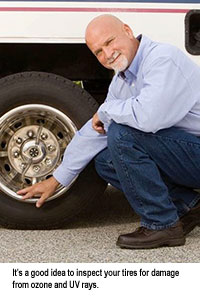|
Spring’s a-comin’, even with a few lingering flurries. Wherever you’ve been hibernating during the winter, you’re probably itching to get your RV out and moving. So now’s a good time to check things out for another season on wheels.
Speaking of wheels, tires are a good place to start — because they are literally the foundation of your RV. We don’t normally think of tires as prone to damage from just sitting around, but they can deteriorate simply sitting in your garage during the winter, or while at a campground in the summer.
So, how can your tires degrade from just sitting around? There are two main culprits:
 Culprit #1 is ozone — the atmospheric gas that seems to have been custom made for breaking down the material your tires are made of called polymers. To protect against ozone damage, tires release protective waxes when they flex while being driven. These waxes end up forming a physical barrier as they cover the tire surface and protect the polymer from ozone damage. Culprit #1 is ozone — the atmospheric gas that seems to have been custom made for breaking down the material your tires are made of called polymers. To protect against ozone damage, tires release protective waxes when they flex while being driven. These waxes end up forming a physical barrier as they cover the tire surface and protect the polymer from ozone damage.
- Culprit #2 is ultraviolet or UV light. You probably didn’t know it, but this dangerous spectrum of sunlight is one of the reasons your tires are black, instead of, say, pink, green or yellow. To protect against UV damage to the tire’s polymers, tire manufacturers use what they call a “competitive absorber” such as carbon black, that captures and absorbs the UV rays instead of letting them harm the tire’s rubber. Carbon black is a very cheap ingredient and quite good as an absorber, while other absorbers are more expensive. As Henry Ford would say, you can have any color you want, as long as it’s black!
 And here’s the upshot: both the waxes and the absorber tend to be effective as long as the tire is in use. If the tire is not in use, these substances tend to break down causing your tires to deteriorate. Common sources of ozone are gas vapors, chemical solvents and combustion of fuels. Damage from UV light can be intensified by highly reflective surfaces like sand or snow. Heat and moisture can also negatively affect tires that have been parked where drainage is poor or the pavement is hot. And here’s the upshot: both the waxes and the absorber tend to be effective as long as the tire is in use. If the tire is not in use, these substances tend to break down causing your tires to deteriorate. Common sources of ozone are gas vapors, chemical solvents and combustion of fuels. Damage from UV light can be intensified by highly reflective surfaces like sand or snow. Heat and moisture can also negatively affect tires that have been parked where drainage is poor or the pavement is hot.
So there are a lot of ways your tires can deteriorate without doing a thing. In our next report we’ll talk about the signs of deterioration and proper tire inspection.
|

 Culprit #1 is ozone — the atmospheric gas that seems to have been custom made for breaking down the material your tires are made of called polymers. To protect against ozone damage, tires release protective waxes when they flex while being driven. These waxes end up forming a physical barrier as they cover the tire surface and protect the polymer from ozone damage.
Culprit #1 is ozone — the atmospheric gas that seems to have been custom made for breaking down the material your tires are made of called polymers. To protect against ozone damage, tires release protective waxes when they flex while being driven. These waxes end up forming a physical barrier as they cover the tire surface and protect the polymer from ozone damage. And here’s the upshot: both the waxes and the absorber tend to be effective as long as the tire is in use. If the tire is not in use, these substances tend to break down causing your tires to deteriorate. Common sources of ozone are gas vapors, chemical solvents and combustion of fuels. Damage from UV light can be intensified by highly reflective surfaces like sand or snow. Heat and moisture can also negatively affect tires that have been parked where drainage is poor or the pavement is hot.
And here’s the upshot: both the waxes and the absorber tend to be effective as long as the tire is in use. If the tire is not in use, these substances tend to break down causing your tires to deteriorate. Common sources of ozone are gas vapors, chemical solvents and combustion of fuels. Damage from UV light can be intensified by highly reflective surfaces like sand or snow. Heat and moisture can also negatively affect tires that have been parked where drainage is poor or the pavement is hot.

